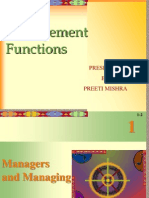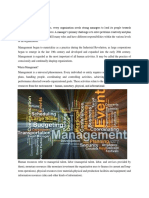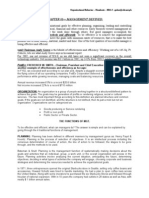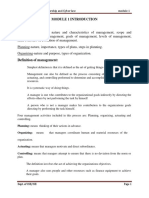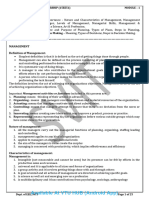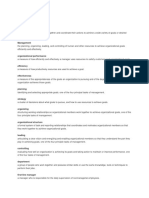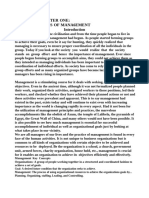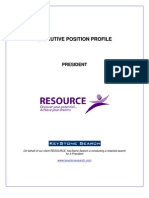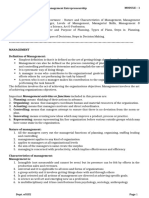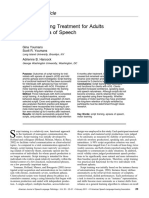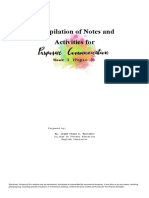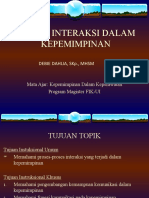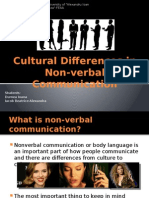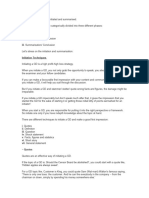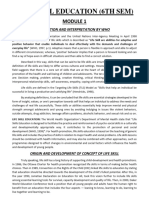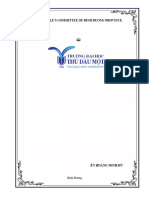Unit 4
Unit 4
Uploaded by
Jennifer BacligCopyright:
Available Formats
Unit 4
Unit 4
Uploaded by
Jennifer BacligCopyright
Available Formats
Share this document
Did you find this document useful?
Is this content inappropriate?
Copyright:
Available Formats
Unit 4
Unit 4
Uploaded by
Jennifer BacligCopyright:
Available Formats
22
Unit IV: Management Functions Applied to Rural Development
Introduction Management is the heart of the organization or any living unit or groups of people like a family, an association, a fraternity, an agency, a peoples organization or society, a government agency, non-government agency, a business enterprise whether micro, small, medium or big organization. These organizations may be profit or non-profit/ service institution. It is management that performs vital functions like planning, organizing, leading, and controlling involving human and non-human resources in the organization in order to achieve pre-determined goals of the organization. Popular rural development major or primary management functions or phases involve planning, implementation, monitoring , documentation and evaluation (PIME). Management, nowadays is not simple as managers thought it to be in the past. Effectiveness and efficiency in the organization are in the hands of management from the bottom to the top level. The management usually carry all the responsibilities in democratic country like the Philippines. The government is continuously training government officials at all levels in the proper performance of their management functions in cooperation with other sectors of government. Continuous education on the local government laws, policies and procedures is done in order to train and update officials to correctly practice mandated and obligatory functions according to the position they are elected or appointed. While managers are thinking of local problems and programs, they should be guided by the global situation and economy. We are all interconnected in one way, small ways and in big ways. Interactive interconnectivity is now very possible with the presence of computers and other communication facilities nowadays. RD managers can tap these resources in development management applying the use e-administration or e-governance in present day management practice. At the end of the chapter, the reader should be able to: a) identify major roles managers in rural development at different levels; b) define and discuss different management functions applied in rural development such as: planning, organizing, leading or directing, communicating, documentation, monitoring and evaluation; and c) present and discuss the different elements of a plan, a program or a project;
23 Rural development goals and objectives are directed toward total human or people development in various culture, political structure, natural and physical resources , laws and philosophy, religious beliefs, desires and aspirations in life. Man as the center and ultimate target of development with all its natural and physical resources development under the supreme human being and the great architect of the universe. This chapter focuses on the unique role of rural development managers, the management functions and the programs they develop and implement. ; Major Roles of Managers Managers in rural development perform different roles which are mandated and expected in the position they occupy. Management has different levels and scope based on the current organizational structure. The roles performed may depend on the level of management whether low level, middle level and top level management which can be identified and seen on the hierarchy of position in the structure. Some of the major roles performed are leadership, managerial, fund sourcing, technical, social or public relations, inspiring, valuing and modeling, and resources protection. There are other roles which you can still enumerate and you will know that it is easy to get the manager position but the performance of the roles are not easy. Each role is briefly discuss as follows: Leadership Role A manager is a leader in his own section, division, organization or in the community, city or province he covers or governs. According to John C. Maxwell (1993) leadership is the ability to obtain followers. Therefore, in order to be a leader, one must have followers or members who believe, accept and follow the power and authority within you and be part in the performance of the functions of the office or position you occupy. Maxwell also concluded that leadership is influence. This is influencing people under you to act, perform and do their jobs or functions to a high degree of performance regardless of motives. A good leader is measured in terms of concrete, measurable and observable organizational performance indicators which lead to the satisfaction of members clients and other stakeholders. Managerial Role Many would like to have high position in office or in any organization they belong. Most people want the position because of the monetary benefits including the power and authority but not the functions or the managerial functions required. What is intriguing is they have limited knowledge and managerial skills particularly on the essential management functions such as
24 planning, organizing, leading, monitoring, documentation, supervising and evaluating. This in addition to fund sourcing, resource mobilization and financial management. Fund Sourcing Role All organizations either public/government or private need funds in order to operate. As you accept the position, the first question you may ask yourself as manager is how much budget the office have in order to operate. If you are in government offices, does the office have budget allocation? How much is the approved budget during your term? What are the manpower, material, physical and financial resources of the organization or the office? Who are involved in the financial management of the organization and what are the income generating programs and projects? Who approve and decide fund allocation and utilization? The fund sourcing role of a manager or head of an organization is very critical to the success of the organization. One must be aware of financial management strategies to generate funds within the organization and obtain funds from external sources either local or international sources. Technical Role You are now a manager which is more on the performance of managerial functions, however your technical expertise or background will surely help you identify new areas or fields where you have great influence. A president who possesses the expertise on crop production may be able to implement outstanding programs and projects in crop production wherein he has previous linkages or partnership before he became a president. If the head of the organization has passion for music and the arts, most of his programs and projects are music and arts which is true in many civic and social organizations. A president of an organization who is a medical doctor usually implemented medical related programs/projects. Social or Public Relations Role All organizations wanted to be known and felt in the area where they operate. As we usually observed, the organization is known because of the social interaction of the officers or members to the community. The programs they implement and the outward observable behaviors of the members are important in order to have more clients, partners, donors and benefactors. Inspiring and Pushing Role This is the motivating role of managers, that is creating an environment of setting high targets or goals to achieve and to really make a difference. This is pushing, influencing, driving or motivating the people in the
25 organization to achieve more, work harder and be on top for the greater development of man and glory to the eyes of God. Valuing and Modeling Role A manager is expected to be an exemplar of good morality, integrity, honesty, wisdom and high standards of culture and excellence. No one is perfect and possesses all these sterling qualities of good managers. But through the years, we always wanted to see managers who are exemplar of good values and will serve as good models in the organization. We look at managers to lead the members of the organization to higher plane of performance and be recognized as such. Resources Protection Role This is now the urgent and immediate needs of the timesthe protection of the God given resources to us like water, soil, air and the natural environment including the human and all living things. Whatever technologies we generate develop and disseminate, resource and environmental protection must always be considered. Let us continue to love, protect and save mother earth, this is the most precious thing we got. Management of Rural Development Programs and Projects Planning: Nature and Concepts Consciously or unconsciously an individual, a group, a family, an organization, or a community makes written or unwritten plans. Planning starts as a psychological process, visioning and concretizing wild imaginations, a process logical thinking, deciding in advance what we would like to happen and achieve in the future, and identifying actions in order to accomplish our goals and purposes in life. Planning is a basic management function of any organization regardless of size, nature, membership, funding sources, principles and core virtues uphold, coverage, objectives and goals. It is basically done at all levels of the system and organization. Plans whether short-term, medium-term, or long range are products or outputs of the planning process performed by an organized group either legitimate or illegitimate. In formal organizations, there are planning teams, consultants or groups who are designated to design the plan of an organization or institution.
26 In rural development, planners or the people involved vary depending on the community, organization, institution and the political structure. Planning is a process of unifying, integrating, organizing in a systematic platforms and consolidating the ideas, beliefs, values concretized into desired programs and projects which are formulated to solve and answer the needs and problems of specific groups of community, clientele or beneficiaries. Planners exert their precious time and talents in order to succeed in achieving goals set. Many believe that plans are blueprint and the roadmap to growth and development. Types of Plans There are so many types of plans, it can be written, unwritten or some are imaginary or visionary plans. We asked some barangay chairmen in the Philippines about the plans or development plans of their respective communities and many of them were able to enumerate ideal and good plans for there villages or barangays. We also found out that many of these are unwritten plans which are products of informal discussions. No document whatsoever can be presented to support there claim that they have development plans. This is at the lowest level of local governance. For municipalities, cities and provinces in the Philippines, there are written development plans since there are Municipal, City or Provincial Planning and Development Offices which are created by government to perform the functions of planning. Some of the plans can be categorized as: 1. Development or Master Plan - A government or non-government institution usually has a development plan/master plan either short term, medium term or long-term which contains the total development perspective of the agency or institution. The general plan may contain the guiding philosophy and principles, core virtues, the long-term vision, mission and goals, agency mandate of creation, context, program thrusts, management and organizational structure, policies and rules, approaches and strategies, linkages and networking, budgetary sources and requirements. The number of years covered or duration of the development plan may differ from agency to agency. 2. Strategic Plan- After the long term development plan has been laid down and approved by proper authorities, the strategic plan is developed by middle level managers or the primary implementers presenting the major problems addressed, major approaches and strategies, human and nonhuman resources available and most importantly the products, measurable outputs or services. Key performance indicators or key result areas are identified. Format or strategic vary from organization to organization. The plan envisions the total organization and its relationship with the external environment or resources.
27 3. Operational Plan or Short Term Plan-The daily, weekly, or monthly activities are done based on the general comprehensive and strategic plan developed. Operational plan is coupled with specific budgetary requirements which are needed in daily operations. The work and financial plan is prepared with corresponding approved budget release. Plans become operational if all resources needed are present and with supportive external environment. Elements of a Development Plan Technically, agencies mandated to implement rural development programs have written development plan which is a product of intelligent and deliberate decision-making process which contain the following: 1. Statement of Philosophy. This is the general statement of beliefs which guide the organization in order to be effective and efficient in the attainment of its vision, mission and goals. 2. Vision Statement. This is a statement of the situation the organization would like to see and achieve for a specific period of time. It is usually unique to the organization, mandate-based, challenging and time-bound. 3. Mission Statement. This is a general statement of what the organization intends to do or what the organization can do to perform its mandate and achieve goals. 4. Goal Statement. In order to achieve the mission, this is broken down into more achievable, realistic, and time-bound targets or general objectives. This is a more systematic, directional, encouraging and transformative process. Measurable indicators are identified, agreed and approved. 5. Program Thrusts. These are major program areas which is anchored on the mandate of agency creation. There are major and secondary program thrusts which are reviewed every year to determine progress. 6. Management and Organizational Structure. This is very important as it shows the manner of governance and organizational structure. This is the arrangement of people in the organization, showing positions and functions including power and authority. This shows the implementing structure on who runs and leads the organization. Not all data and information are presented in the structure, however the structure gives an overview on the context of the organizational management. 7. Approaches and Strategies. These include the technical and social technologies used by the organization in running the organization which is guided by the philosophy uphold by the organization. Approaches and strategies are agreed upon since it requires some legal, educational and financial requirements .
28
8. Policies and Rules. Above all, the organization is guided by the laws of the land as well as the existing political structure, culture and climate in the whole system. There approved policies and rules of the organization as well from the higher political structure of government and from the funding or sponsoring institutions. The members of the organization must be aware of these policies and rules and it is the responsibility of the officers or people in administration to communicate and explain the policies and rules. 9. Budgetary Requirement and Fund Sources. This is basic in running any organization. The organization must be aware of the fund sources, fund allocation every year, budgetary requirement or needs and fund generation and utilization. One of the major competencies of people in governance is the preparation of the long term development program, strategic plan, operational plan, program and project proposal preparation and submission. Resource mobilization is a primary function of managers. The organizational performance is highly influenced by the financial generation and utilization and its resource linkages and networks. 10. Linkaging and Networking. The organization is just a part of a big system and therefore it usually works with other similar organizations or agencies with the same goals and objectives. In terms of programs, fund sources and complementation of technical, material, financial and other physical resources, the agency may work with other agencies where both benefit from the partnership. 11. Work and Financial Plan. In the final planning, how much fund does the organization need? This is always the main concern of top management on how to generate needed financial resource. Plans are always determined by the funds approved and released. 12. Attachments. These are additional documents like maps, land use plans, description of facilities and structures, list of manpower, problem analysis, program framework, list of partners, donors and client description. Why do we make plans/ organizational plans? Plans are basic documents and mandatory requirements in any agency or type of organization. A comprehensive development plan presents almost all information about the agency or organization. It may not be complete 100 percent but more or less the basic information about he organization are written. Every individual in his right frame of mind, consciously or unconsciously formulates his own professional and personal plans. These are expressions of what we would like to achieve. Plans of any sort is a product or outputs of a deliberate planning process. Some of the reasons and advantage of planning are: Planning justifies existence
29 Planning rationalizes the funds provided Planning systematizes and organizes courses of action Planning minimizes mistakes and uncertainties in implementation Planning enhances effectiveness and efficiency and avoid waste of resources Planning unifies the organization towards common goals Planning facilitates division of labor and avoid duplication of efforts or labor Planning creates an environment of order and discipline Planning sets clear individual and group performance indicators Planning promotes cooperation, coordination, complementation and improves members or employees moral Planning makes the agency think and design innovations, new technologies, strategies and information Planning attempts to make good forecast of the future Planning aims for success Planning, therefore is a basic and primary management function of an organization. It is the act of conceptualizing, developing, implementing and sustaining the plan. Planning requires creative, innovative, rationale, human-oriented thinking and decision making. Developing a Plan In developing a plan, there are different stakeholders, actors or people involved. There are several factors or issues to be resolved before developing a plan, these are the type of plan, people (insiders and outsiders) involved in planning, area and clientele or beneficiaries to be covered, problems and needs to be solved, resources (human and non-human resources) available, mandate from the national level of government or the organization, duration of the plan, sources of funds, strategies of fund generation and maybe other factors from the external environment. Type and Kind of Plan According to Type a. Comprehensive development plan - barangay, city, municipality, province, region, government agency, non-government organization, cooperatives, farmers association, peoples organization which maybe covering a number of program areas or thrusts. b. Sectoral plan - agriculture, health and nutrition, economic, social, environmental, infrastructure, land use plan, investment plan, physical development plan, school plan, etc.
30 c. Functional plan - production, processing, post-harvest, marketing plan, financial plan, recreational plan. According to Duration a. Short-term Plan - this may be daily, weekly, monthly, semestral, quarterly, annual plans. Plans shorter than three years can be said to be short term. b. Medium Term Plan - Plans more than three up to six years are medium term plans. c. Long Term Plan - Plans more than six years are long term. These are just arbitrary labeling of duration. It depends on the organization or agency whether they want to be called short, medium or long term plan. According to People Involved in Planning a. Top level b. Middle level c. Low level According to Political Jurisdiction a. b. c. d. e. Barangayl level City/municipal level Provincial level Regional level National level
According to Initiators or Actors of the Planning Process a. Internally initiated planning. Members as main planners b. Externally assisted planning. Government or non-government personnel assist groups or organization in developing the plans. c. Consultancy or Professional Assisted Planning. Some organizations or groups hire consultants to assist in planning. d. Joint-planning. This is an example of partnership between local (barangay) people and government or private sector working together in making a plan. Five Major Phases in the Development of a Plan a. b. c. d. Pre-planning Planning Proper Presentation, Submission and Approval of the Plan Budget Allocation and Release
31 e. Preparation of Actual Workplan Pre-Planning Phase This involves environmental or resource scanning of human, material, physical, natural, and institutional resources. In popular term, it is a community study and analysis of the area. Usually, planners use secondary data that are already existing in the area like the barangay, municipal or city hall or local offices and from provincial and regional offices. Benchmark or baseline surveys are sometimes not necessary. Maybe what they need is just data updating through focus group discussions and data from key informants in the area in order to come up with benchmark data and information. Funding for a full blown and long term environmental scanning maybe a waste of time and money. Participatory rapid appraisal (PRA) or rural rapid appraisal (RRA) whichever is appropriate may be used. Participatory development planning may be more useful and developmental in nature. Data from barangay, city, municipal or provincial profile are in many cases available such as: a. b. c. d. Historical Geographic and Climatic Demographic Economic Agricultural data Industry data Service sector Employment data Overseas Filipino Workers
e. Social data include educational, health, nutrition, housing, peace and order) f. Infrastructure - barangay hall, health center, multipurpose gym or center, recreational center, basketball court, wellness center, cockpit arena, resort, marketing center, g. Road system and networks, bridges h. Transportation and communication i. Institutional-banks, pawnshop, market, j. Political k. Cultural Activities, Traditions l. Ecological Solid Waste Management Program m. Tourist Attractions or Sites n. Other Information
32
Ways of Data Gathering Team of planners whether internal or external can used various forms of data gathering specifically when time to gather data or perform resource scanning is very short and with limited funds. a. Actual area observation, walk through, field visitation by the local people with outsiders are useful using a land use map, crops planted, residential area, fishing, forest area, pasture, mangrove and orchard. b. Primary data gathering-conduct of household survey, select group survey, personal interview of key informants, focus group discussion, informal discussion, pre-planning meetings, workshops and other participatory planning strategies. c. Secondary and primary data can be obtained through consultative participatory planning with personnel of government agencies and local offices in the province, city, and municipality like : Agriculture Office Cooperative Office Social work and Development Office Health Office Nutrition Office Environment and Natural Resources Planning and Development Office Engineering Office Solid Waste Management Office Association of Barangay Chairmen Office Samahang Kabataan Office Department of Agrarian Reform Department of Trade and Industry Department of Public Works and Highways National Irrigation Administration Department of Science and Technology National Power Corporation Electric Company d. Secondary and primary data can be obtained through consultative participatory planning with religious, civic, social, fraternal, sports, charitable organizations and the private or business sectors. e. Secondary and primary data can be obtained through consultative participatory planning with different local or provincial boards created and recognized by the local government like school board, solid waste management board, peace and order board, agriculture and economic
33 board, health and nutrition board, environmental management board and others. f. National data obtained from national offices and through internet access. There are various ways of data gathering either direct or known mean and other in direct means or secret ways. Data and information may not be 100 percent accurate, but for planning purposes these data can be a good start. It is very ideal that if it is a community development planning, the people and the outsiders must work together in trying to understand and develop the plan. Data Organization and Analysis. The data gathered must be grouped and organized in a manner that will describe the situation in quantitative platforms understandable to all: the local people, the development or extension workers, the technical consultants, and other members of the planning team. Simple descriptive statistical analysis can be used to make data more useful and informational. All data sources must be noted or recorded for proper acknowledgment and data accountability. This is to give due recognition for the people and offices who gathered, consolidated and kept the data in usable format for public use. Qualitative data can also be used, and similar to quantitative data it must also e properly noted and acknowledged. Planning Proper The steps in planning is already known to many of us, as you have been doing a lot of planning meetings and workshops. There are various steps in planning depending on the kind of plan, nature of the plan, program areas, coverage, commitment and dedication to do a SMART PLAN. 1. Organize the Planning Team. Who are involved or who are the members of the planning team? There are legal individuals elected or appointed to formulate the plans in the barangay, city, municipality, province, region, national level. The planning process must be known to everyone that the plan shall be formulated through democratic representation, undergo a process of deliberation and approval in a public hearing if it is a community development plan. Similar in government agencies, offices have specific process of plan formulation, from the section, division up to the department level which need approval of the technical planning team or executive councils, before submission to the chief of office for final endorsements to the higher chief executive for budget allocation and approval.
34
At the local leveI, it is very ideal that the planning team of a community or barangay, city, municipal or provincial comprehensive development plan will be composed of the following but not limited to those listed below: a. b. c. d. e. f. g. h. i. j. Elected members of the barangay, city, municipal provincial council Appointed or designated secretary Appointed or designated treasurer Chairmen of committees Representatives of different legal organizations Representatives of schools Representatives of the indigenous groups/communities Representatives of religious groups Other volunteer local leaders (limit the number) Representatives from different department s or offices who can contribute or provide technical expertise to the plan to be developed.
2. Problem Identification and Prioritization. Every organization or agency has mandate which guided them on what problem areas or concerns to address. In the Philippines, many agencies are named after the commodity they are working on like the Philippine Carabao Center(PCC), Philippine Rice Research Institute (PhilRice), Bureau of Fisheries and Aquatic Resources (BFAR), and therefore they may be working on the various major problems of the commodity and the industry. Deliberate and serious problem analysis of the commodity are usually done thereby formulating programs and projects that will find solutions to the problems at hand through research, development and commercialization. In rural development, the barangay planning team shall face various problems areas of concern and the lowest local government unit must be taught, trained and trusted (3 Ts) to solve these problems . As mentioned in number 1, the barangay can have similar legal planning teams, to assist the barangay council formulate relevant programs and projects. There are so many areas of concern in a barangay or community like: a. b. c. d. e. f. g. h. i. Agriculture and Food Livelihood and Employment Generation Education and Training Health and Nutrition Housing Water ,Power or Electricity Peace and Order Entrepreneur Development Disaster Management
35 j. k. l. m. n. o. Watershed Protection Solid Waste Management Spiritual and Values Development Infrastructure Development Communication and Transportation Other areas
There are options or planning strategies to take, the barangay can select five areas which should be given priority since the barangay can not solve the all the problems at the same time. There are problems that solutions are long term, while there are problems wherein solutions are short tem or can be solve within a year. Programs and projects formulated and identified must be problem and need-based. This is the main reason for making a plan, to identify which problem area should be given priority attention and selection of problem area must come from the people who are the direct beneficiaries of the program not the donor or sponsor of the funds. Committees of groups can be organized at the barangay level to map out the initial plan based on the problems and needs identified. These can be presented and deliberated to a bigger group of legitimate people in the barangay before final approval and public hearing. Similar with many religious, civic, social and charitable organizations, they must ask the barangay or community first before sponsoring projects or providing any assistance in the community. Simple problem analysis can be used to scrutinize the cause and effect of the problems at hand. 3. Determine solutions and set clear goals. The programs and projects identified with clear goals set must be clear, realistic, specific, acceptable, approve by the legal body and easy to measure. Definitely, these goals to be achieved must be an answer to the problems at hand. Issues and problems must be properly addressed. Solutions to the problems must be: a) socially acceptable, b) technically sound, c) economically feasible, d) environment friendly, e) morally right , and f) presence of support from the people in the barangay, and other fund sources like donors and government agencies or private sectors. 4. Formulate strategies to achieve goals set. Based on the past experiences and available human, material and financial resources, the planning team can identify strategies that will fast track implementation of activities. The planning can be assisted by external development extension workers or experts in planning.
36 5. Identify the necessary inputs or requirements of the program/project. These inputs maybe human, material,, land, financial, building or facilities, technology, information, training or other legal requirements. All these must be properly identified including the sources and processes necessary to be done. 6. Timeframe or the target date of implementation and the people responsible. The strategic plan must be done first and later the operational plan per project must be specified. This will specify what are the activities to be done, who are the responsible persons groups, target date of implementation, place and materials or supplies needed. 7. Writing the plan, requirements. Contents of Different Plans There are different formats and contents of development plan, strategic plan and operational plan. These are just some of the common contents or elements which may serve as bases or guides in writing the plan. 1. Comprehensive Community or Barangay Development Plan Title of the Plan including the area (cover page) Timeframe or Duration Table of Contents Introduction Situationer/Profile of the Community Major Problems Identified Vision, Mission, Goals Programs and Projects with Key Result Area Management and Organizational Structure Strategies and Approaches Strategic and Operational Plan Core Values Budgetary Requirements Partners in Development Monitoring and Evaluation Program Review and Re-planning Attachments 2. Strategic Plan (this can be written in horizontal tabular format) Target Goals Programs/Projects under each Goal Measurable Key Performance Indicators Major Strategies and Approaches presentation and including the budgetary
37 Target Date or Duration per Quarter, per Year Budgetary Requirements Partners, Cooperating, Funding Agencies
3. Operational Plan (this can be written in horizontal tabular format) Programs/Projects Specific Objectives Strategies Activities to be undertaken Target Date Responsible person or groups Budget needed 4. Operational Plan or Workplan Projects Activities Target date Manpower and materials needed Budget needed Reminders or Guides in Making and Implementing the Plans Workplans or operational plans are finalized based on the program or project proposal document approved and the strategic plans which were submitted to the funding agency and the budget released. If there is a Memorandum of Agreement executed and signed by contracting parties, the implementer must be familiar with the approved and released budget, approved items of expenditures and the timeline of activities. Project team members must meet regularly, if possible, daily, weekly or monthly to tract where they are now, the status of activities, problems met and alternative actions. Transparency and honesty must always be present. Teach, train and trust people, they are your allies and team members. Remember, if you are the head of the project, any mistakes they make you are accountable to the funding or donor agency. If you are the barangay chairman, mistakes in any construction and errors in project implemented by your group will be pose negative impressions against you. Documentation in various forms is a must thereby monitoring of all activities must be done to see to it that all specifications or actions are within the plan. Any unforeseen event that destroys the project must be looked into and properly reported. Any deviation form the plan must be properly explained.
38 Evaluation of accomplishments is a must. Recognition of those who exert extra efforts, sponsors, donors as well as those who are the beneficiaries of the project must be recognized. Public accounting may be done to showcase real expenditures, if possible. Organizing Function Managers, heads of offices or an ordinary barangay chairman is responsible of planning and implementing several programs and projects in particular period of time. The programs and projects are divided or broken down into different tasks. Another important major function that managers must know is organizing. This function involves the following: a) grouping of tasks or related tasks, b) identifying and assigning people to perform such tasks, c) allocation of resources needed by the person or group to perform the tasks, and d) delegating authority in the performance of the tasks. Managers as leaders perform great function in motivating and influencing people to perform assigned tasks with high degree of commitment and dedication. Proper organizing establishes protocol, order and systematic procedures in task performance. Equality of task performance according to remuneration, assigning or hiring the correct person with appropriate technical expertise coupled with proper work values and attitudes shall contribute to the completion of the tasks. There are several ways of grouping or organizing tasks. The structure of an organization, technically may be organized or group according to: a) Functional areas instruction, research, extension, training, production, Administration. b) Commodity - corn, rice, legumes, vegetables, high value crops c) Discipline or Field genetics, crop production, post-harvest, control of pests and diseases d) Combination a, b, c e) Sectoral or Work Area Factors that Influence Organizational Structure(www.cliffsnotes.com) a) b) c) d) e) Organizational size Organizational life cycle Strategy Environment Technology
Guides in Organizing
39 a) Organizational structure must be approved by proper authorities. b) Functions must be clear, accepted and communicated. c) Assignment of tasks must be in written form known by all. d) Regular monitoring and review of assignments must be done. e) Feedback mechanism is highly necessary. Leading Function It is a basic requirement that every organization must have a leader who are good managers. In order to be a leader, you must have followers or a group of people whom you lead toward the attainment common goal. In any democratic country, people can select the people who will lead them particularly in governance of the country. Through clean and honest election, people can select the best leader to govern and give them the best service the people need. According to John Maxwell (1993) in his book Developing the Leader Within You leadership skills determine the level of your successand the success of those who work around you. An organization has high performance because the leader has the ability to influence or lead others successfully. This is teaching, training, guiding motivating, influencing, challenging, encouraging people under you or the members of your organization to work and give their best and achieve high level of work performance. Remember, a leader or manager is measured in terms of his outputs in terms of measurable organizational performance indicators like effectiveness, efficiency, client satisfaction as well as employee satisfaction. It can be said that leadership is an unseen force that binds the members or group together toward the desired goals. Nature of Leadership Leadership skills are in-born and acquired traits by the person through education and training. Leadership involves direction-setting through formulation of realistic vision, mission, goals coupled with correct Christian values and motivation. Leadership must be coupled with good and practical management skills. Leadership requires political skills, that is the art of governance according to the rules and policies of the agency or organization. Leadership involves the continuous process of creating and introducing innovations, technologies and information to make organizational climate interesting. Leadership requires setting of priorities, identifying which are important since resources are always scarce.
40 Leadership continuously create positive change in the organization and sustain organizational performance to a higher level. Leadership involves high level skills and sensitivity in terms of problem identification and solution formulation. It is conflict mitigation in the organization. Leadership develops other to be future leaders: 3 Ts-Teach, Train and Trust. This requires a well-planned human resource development in order to sustain the leadership in the organization. Leadership has high sense of progressive vision of development.
Characteristics and Competencies of a Leader in RD Exemplar of good human values Mastery of management functions applied to rural development Professional leader who believe on the philosophy and principles of his discipline or the organization Social skills in dealing with people of different economic, social, political status and culture Possess good communication skills (written and oral) Organize, scientific, and systematic Visionary Resource mobilization Efficient in resource utilization Good mental and physical health Flexibility Sensitive or alert to the environment-physical, social, technical, economic, political Team builder Leading others to become leaders: developing the leaders around you. Strategies to Create Good Climate of Leadership In every organization, there is a need to continuously strengthen the bond among members. A leader must be conscious of strategies or ways to sustain the trust and confidence o his members to him as a leader. Some of the ways are: 1. Set regular date and place of meeting to update yourself of the progress of the project or task. 2. The regular meeting must be exciting where members are motivated to attend and not scared because it is reporting time. Some energizer, games, news, jokes or educational activity can be included as part of the meeting . 3. Prayer is always the beginning and end of the meeting.
41 4. In any organization, there must be team building activity like off-campus meeting, cross-visits, educational tour that makes work an enjoyable one. 5. Promotion or any financial benefits must be fair to all, that is giving reward for those who exert extra effort contributing to high level of performance. 6. Establishing the climate of trust and love among members as one family working together a common goal. 7. Recognition of a work well done through financial reward if possible, promotion, or trip to other country or any other form of incentives. 8. Well-organize workplan, training in report preparation, presentation, analysis and evaluation. 9. Success is always credited to the group and not to the leader only. 10. Plan to succeed as a group. Set realistic targets. Communication Function Communication is the act and dynamic process of interaction between humans and among members of an organization. It involves conscious and unconscious sending, transmitting, exchanging, and receiving messages. The communication process can be verbal or non-verbal. With the computer technology, the process of communication becomes high tech and unimaginable. The sending and receiving of information is very fast using different modes and revolutionize peoples lives throughout the globe.. The elements of the communication process are: SENDER, MESSAGE, CHANNEL, RECEIVER, EFFECT or RESPONSE. We will not deal on concepts and theories, this section shall discuss importance of effective communication process in rural development. Let us explore the purposes of communication by a RD manager from a government agency based on his roles and functions. The manager is communicating in order to: 1. Directs and leads his staff to make plans. 2. Informs the staff of new programs, projects, policies and rules. 3. Teaches and updates the staff new technologies, information, strategies and approaches. 4. Persuades staff to be more resourceful and human-oriented. 5. Motivates his staff to high level of commitment, dedication service and excellence. 6. Instructs his staff to follow approved workplans. 7. Advises his staff to follow the rules, policies, observe safety procedures, protect the environment, and conserve energy. 8. Builds mutual trust and confidence.
42 9. Shows love and concern to his staff. Everyone is important in the organization. 10. Warns his staff of forthcoming danger or disaster. Message In any communication transaction, the sender must always remember three major factors: Message Code -- set of symbols, language , signs Message Content -- clear, concise, relevant, timely, Message Treatment the way the message is presentedfrequency, redundancy, emphasis, express feelings. Types of Communication 1. Interpersonal Communication 2. Intrapersonal Communication 3. Media Communicationmediated communication with the use of electronic media 4. Mass Communication Factors in the Use of Channels in Communication 1. Communication skills of both sender and receiver 2. Message topics or information 3. Cost of the channel used 4. Availability of facilities or equipment 5. Supplies and materials 6. Presence of power or electricity 7. Purposes of communication 8. Immediacy of response 9. Importance of the message 10. Educational level of both sender and receiver 11. Location of both sender and receiver 12. Climate or weather 13. Other factors Documentation, Monitoring and Evaluation (DME) Functions These three management functions are inseparable specifically in the implementation of RD programs and projects. Documentation Is the process of providing evidence. It is the act of supplying documents or supporting references or record. It also means the collation,
43 ,synopsizing, and coding of printed materials for future reference (http://en.wikipedia.org/wiki/Documentation).. It is the accumulation, classification, and dissemination of information (http://www.ifla.org/VII/s30/pub/mg). Is the recorded or pictorial information describing, defining, specifying, reporting, or certifying activities, requirements, procedures, or results related to quality assurance. It is the written ( or otherwise recorded) information aboput a target required for an evaluation (http://www.mijnwoordenboek.nl/). Monitoring Is a type of evaluation of a project, program, activity while it is being implemented, with the aim of improving the project design, and functioning while in action. Is a continuing function that aims to provide the management and main stakeholders of an ongoing intervention or actions. It is a systematic collection and analysis of data and information from project implementers as project progresses. It aims to improve effectiveness and efficiency of the project. Monitoring is based on target sets and activities planned (Shapiro, J. 1996) Evaluation Asses the outcomes of a project with the aim of improving future project implementation. It is a systematic and objective study of determining the extent of attainment of objectives or set targets of the project or program. It is the comparison between actual project performance against agreed and approved strategic plans. It is planned targets versus actual performance. It requires scientific methods, adequate manpower, funds and other logistic support. It ultimate aim is to improve organizational performance and capabilities of implementers. Is the bases of promotion and growth of the organization; in business it is the base for expansion and increasing investments. It sometimes require measurable, concrete and observable indicators Results are written and submitted to funding agencies. In rural development projects DME, some basic and important questions must be answered or must be considered:
44 1. What to document? Monitor? Evaluate? person, program, project, activity. 2. What are the purposes of DME? Determining accomplishments, for extension or continuation, for promotion, for revision. 3. Who will do the DME? Internal staff, external consultants or agencies 4. How extensive is the DME? Formal, informal casual 5. How much is the budget needed? 6. When is the DME be conducted? Beginning of the project, ongoing, terminal or final project completion 7. What are the methods and strategies to be used? Observation, survey, records, reports, focus group interviews, actual field measurements or data gathering, 8. How are the data to be analyzed? Manual, computer-based analysis, statistical tools to be used. 9. How are the results be consolidated, reported and presented? 10. To whom the DME results be submitted? Funding agency, partner agency, cooperating agency, clients, others. 11. Secrecy or confidentiality of DME results. Types of Monitoring and Evaluation Self evaluation Participatory evaluation Formal and Semi-formal evaluation Rapid Participatory Appraisal External Evaluation Interactive evaluation
Evaluation generally follows the scientific research process and methods in rural development specifically the social research and economic research methods are usually used in evaluating projects. Even the formats and content are highly similar to educational, economic and other social researches. At present, many evaluation studies used interdisciplinary approaches wherein a team of experts conduct evaluation studies.
45
REFERENCES Agricultural Training Institute. 2005. Building Dreams,Changing Lives. Vol. ATIs Treasury of Inspiring Stories. Apruebo, Roxel A. 2006. 1st Edition. Essentials of Organizational Behavior. Educational Publishing House, Ermita, Manila. Azanza, Patrick Alain, Rodolfo V. Azanza, Rodolfo T. Azanza, Jr., Rosario T. Azanza. 2001. Economics, Society and Development: A Textbook in Economics. National Book Store. Aquino, Gaudencio V. Educational Administration Theory and Practice. Rex Book Store, Manila. Battad, Fortunato A. 2005. Born to Lead. Central Luzon State University, Science City of Muoz, Nueva Ecija. Battad, Teodora T. et al. 2003. Administration of Rural Development Projects. Central Luzon State University, Science City of Muoz, Nueva Ecija. Chauhan, Anita M., Ester V. Tucay, Aladino L. Leccio, Florentina S. Dumlao. PAEPI 2003. NSTP Resource Book on Community Organizing and Extension. Love Printing Press. Coloma, P.S., T.T. Battad and A.S. Paderes. 2003. Agricultural Extension. De Leon, Alwin B. 2005. Practicing Community Development Principles in our Barangays. Megabooks Company. Fajardo, Feliciano R. Management. Published and distributed by Rex Book Store. Food and Agriculture Organization of the United Nations. 1986. Guidelines for Designing Development Projects to Benefits the Rural Poor. Garcia, Manuel B. Focus on Teaching Approaches, Methods and Techniques. Rex Book Store, Manila. Ivancevich, John M. and Michael T. Matteson. Sixth Edition. Organizational Behavior and Management. McGraw-Hill Higher Education.
46
King, David. 2002. You Can be Rich. World Link Marketing Corporation. Korten, Frances F., Robert Y. Siy, Jr. 1989. Transforming a Bureaucracy: The Experience of the Philippine National Irrigation Administration. Ateneo de Manila University Press. Lamucho, Victoria S. 2004. Mirrors of the Heart. Copyright by Mutya Publishing House and Printed by Mega Jesta Prints, Inc. Leveriza, Jose P. Human Behavior in Organization. Approach. National Book Store. A Multi-Disciplinary
Leveriza, Jose P. 1983. Public Administration: The Business of Government. 2nd Edition. National Book Store. Linao, Rex T. 2004. Community Immersion Toward Becoming Agents of Community Empowerment. Great Books Trading. Martires, Concepcion R. 3rd Edition. Human Resources Management. Principles and Practices. National Book Store. Miranda, Gregorio S. and Carmelita M. Miranda Gow. 2002. Management Principles and Practices. Updated Edition. 2002. Published by L&G Business House. Navarra, Rex L. 1993. Towards Peoples Empowerment: GO-NGO Collaboration in Agricultural Development. Philippine Rice Research Institute. Maligaya, Muoz, Nueva Ecija. Newstrom, John W. 2007. 12th Edition. Organizational Behavior: Behavior at Work. McGraw-Hill International Edition. Human
Rasul, Jainal D., Sr. 2003. World Religions: Pathways to Heaven. CARE Minorities, Inc. Quezon City, Philippines. Rivera, Fermina T., J.A. Irabagon and C.C. Divina. Re-engineering Graduate Education: The CLSU Experience. Institute of Graduate Studies, Central Luzon State University, Science City of Muoz, Nueva Ecija, Philippines. Singh, Katar. 2nd Edition. Rural Development: Management. Sage Publications, New Delhi. Principles, Policies and
United Nations Economic and Social Commission for Asia and the Pacific. Operationalizing Local Level Planning. Bangkok.
47 University Extension Program-Management Institute for Rural Development, Research, Extension and Training. Central Luzon State University, Science City of Muoz, Nueva Ecija. GO-NGO-PO Networking: A Model for Rural Development. Waterson, Albert. Development Planning Lessons of Experience. John Hopkins Press. Baltimore, Maryland. Zulueta, Francisco M., Greg Melchor Castro de Lara and Abriel M. Nebres. 1999. Management Theories and Practices. Academic Publishing Corporation.
You might also like
- Inter-Act 14th Edition Com35 PDFDocument498 pagesInter-Act 14th Edition Com35 PDFStella Greco93% (15)
- Ch04 Discourse Analysis 2ndeditionDocument17 pagesCh04 Discourse Analysis 2ndeditionPopoveniuc Neli100% (1)
- Speech Act TheoryDocument21 pagesSpeech Act TheoryOde Kone Egoisyaegois100% (5)
- Organisation Theory and BehaviourDocument11 pagesOrganisation Theory and BehaviourSammir MalhotraNo ratings yet
- Module in Introduction To Management and Leadership 2Document102 pagesModule in Introduction To Management and Leadership 2vanessa edaniolNo ratings yet
- HBO Lesson 1Document16 pagesHBO Lesson 1glydel jubayNo ratings yet
- Faculty of Business and ManagementDocument8 pagesFaculty of Business and ManagementSasa VathiNo ratings yet
- Manager ResponsibilityDocument11 pagesManager Responsibilityqbn9vx7t9jNo ratings yet
- MGMTDocument64 pagesMGMTሻሎም ሃፒ ታዲNo ratings yet
- ManagementDocument15 pagesManagementMD. JAHIDUL ISLAMNo ratings yet
- Introduction To ManagementDocument14 pagesIntroduction To ManagementFloRhyda DahinoNo ratings yet
- What Is Management (AutoRecovered)Document4 pagesWhat Is Management (AutoRecovered)Ken Sam GabriolaNo ratings yet
- Enterprenur ManagementDocument34 pagesEnterprenur ManagementmalamnazeeNo ratings yet
- G&C 3Document7 pagesG&C 3Cha-chaGeñoso0% (1)
- ECU302 LEC ON Business ManagementDocument14 pagesECU302 LEC ON Business ManagementKimani JohnNo ratings yet
- THE CONCEPT OF THE CHIEF EXECUTIVE OFFICER AND ITSDocument6 pagesTHE CONCEPT OF THE CHIEF EXECUTIVE OFFICER AND ITS2chandlershad23No ratings yet
- POM - Unit 4Document13 pagesPOM - Unit 4sayantani mukherjeeNo ratings yet
- Relationship Between Planning and Controlling Functions in ManagementDocument24 pagesRelationship Between Planning and Controlling Functions in ManagementSezan Tanvir83% (6)
- Management in TourismDocument6 pagesManagement in TourismMAIFUJA KHATUNNo ratings yet
- ManagementDocument35 pagesManagementGizachew AbeshaNo ratings yet
- How Do You Define Management?/ How Would You Define Management? October-2010, November-2007Document117 pagesHow Do You Define Management?/ How Would You Define Management? October-2010, November-2007Nahid HossainNo ratings yet
- M1 TimeDocument16 pagesM1 Timeczys696969No ratings yet
- pom unit iDocument9 pagespom unit igrowthgear93No ratings yet
- Mgmtchap 2Document103 pagesMgmtchap 2Galex BaakNo ratings yet
- BcaDocument24 pagesBcajayaviy386No ratings yet
- MANAGEMENTDocument17 pagesMANAGEMENTsqNo ratings yet
- Fundamentals of ManagementDocument14 pagesFundamentals of ManagementJR PagaduanNo ratings yet
- Symbiosis Institute of Health Sciences (SIHS)Document5 pagesSymbiosis Institute of Health Sciences (SIHS)ShivamNo ratings yet
- Unit1 ManagementDocument24 pagesUnit1 ManagementAkshat KalaNo ratings yet
- Every Organization Has Managers' Who Are Entrusted With The Responsibility of Guiding and Directing The Organization To Achieve Its GoalsDocument31 pagesEvery Organization Has Managers' Who Are Entrusted With The Responsibility of Guiding and Directing The Organization To Achieve Its GoalsMonika SachdevaNo ratings yet
- Management Functions: Presented BY Preeti MishraDocument43 pagesManagement Functions: Presented BY Preeti MishraPreeti Mishra DubeyNo ratings yet
- 1 Basic Concepts 123Document49 pages1 Basic Concepts 123earlNo ratings yet
- EEE512 Module 1Document88 pagesEEE512 Module 1Ntokozo Masuku NsmNo ratings yet
- Principles of Management Unit OneDocument25 pagesPrinciples of Management Unit Onecatherinechanda321No ratings yet
- Demonstrate The Importance of Interpersonal Skills in The WorkplaceDocument7 pagesDemonstrate The Importance of Interpersonal Skills in The WorkplaceIsha AgrawalNo ratings yet
- All About ManagementDocument121 pagesAll About ManagementMayangNo ratings yet
- Chapter 01 - Management Defined:: Ntel Chairman Andy GroveDocument16 pagesChapter 01 - Management Defined:: Ntel Chairman Andy Groveparo79No ratings yet
- Group 1 AdministrationDocument19 pagesGroup 1 AdministrationBridget Tivavone MutaramutswaNo ratings yet
- Managerial IssuesDocument118 pagesManagerial Issuesokeke chukwuemekaNo ratings yet
- X 5Document6 pagesX 5andrewNo ratings yet
- Interpersonal SkillsDocument9 pagesInterpersonal SkillsAna Umar100% (3)
- Me Full-1Document95 pagesMe Full-1Aishwarya LakshmanNo ratings yet
- Module 1 Introduction: Planning: Means Thinking of Their Actions in Advance. OrganizingDocument34 pagesModule 1 Introduction: Planning: Means Thinking of Their Actions in Advance. OrganizingAbhishek WilsonNo ratings yet
- Business ManagementDocument64 pagesBusiness Managementshantel tinotendaNo ratings yet
- CHAPTER 1 ManagementDocument16 pagesCHAPTER 1 ManagementSemNo ratings yet
- Chapter Two Management Competencies For TodayDocument17 pagesChapter Two Management Competencies For Todaykaamildheere071No ratings yet
- Well Come To The World of Management! Unit OneDocument50 pagesWell Come To The World of Management! Unit OneAYNETU TEREFENo ratings yet
- Available at VTU HUB (Android App) : Management & Entrepreneurship (15ee51) Module - 1Document25 pagesAvailable at VTU HUB (Android App) : Management & Entrepreneurship (15ee51) Module - 1Khivan AvtarNo ratings yet
- Combine PDFDocument108 pagesCombine PDFKhivan AvtarNo ratings yet
- Managers and ManagingDocument164 pagesManagers and ManagingRahul VichareNo ratings yet
- Me Mod1@Azdocuments - inDocument25 pagesMe Mod1@Azdocuments - insailajavenki1980No ratings yet
- Intr. Mgmt Chapter OneDocument15 pagesIntr. Mgmt Chapter OneTeferi GetaNo ratings yet
- Terminals Answers - ImportantDocument22 pagesTerminals Answers - Importantsanjeev misraNo ratings yet
- Lecturer Demo ManagementDocument11 pagesLecturer Demo ManagementshemooNo ratings yet
- Executive Profile - President of RESOURCEDocument6 pagesExecutive Profile - President of RESOURCELars LeafbladNo ratings yet
- Nursing Service ManagementDocument13 pagesNursing Service ManagementPrincess Melanie MelendezNo ratings yet
- Bornasal Assignment No. 2Document10 pagesBornasal Assignment No. 2nena cabañesNo ratings yet
- Final Module 1 - NMDocument20 pagesFinal Module 1 - NMBoban MathewsNo ratings yet
- Module 4Document12 pagesModule 4Ma. Veronica UnarceNo ratings yet
- Organizational Behavior (ALD 2202) Instructor: Professor Dr. ABM Shahidul Islam Dept. of Marketing, University of DhakaDocument3 pagesOrganizational Behavior (ALD 2202) Instructor: Professor Dr. ABM Shahidul Islam Dept. of Marketing, University of DhakaAsif ZobaedNo ratings yet
- QuranDocument4 pagesQuranTahir AlyNo ratings yet
- Direction Function AssignmentDocument7 pagesDirection Function AssignmentUdaypal Singh RawatNo ratings yet
- Professional Communication - Notes: Levels & Barriers of CommunicationDocument8 pagesProfessional Communication - Notes: Levels & Barriers of CommunicationRishavNo ratings yet
- Script Training Treatment For Adults With Apraxia of Speech PDFDocument16 pagesScript Training Treatment For Adults With Apraxia of Speech PDFFlorino Jentea100% (1)
- Compilation of Notes and Activities For: Week 3 (Topic 3)Document9 pagesCompilation of Notes and Activities For: Week 3 (Topic 3)mascardo franzNo ratings yet
- FunctionalismDocument22 pagesFunctionalismTomás Torres Girón67% (3)
- Behavsci 12 00425Document24 pagesBehavsci 12 00425NicoleNo ratings yet
- Oral Com Hometask 5Document2 pagesOral Com Hometask 5Angelo LlanosNo ratings yet
- SKillSoft Books 24x7Document85 pagesSKillSoft Books 24x7Gaynell Dudley100% (1)
- Proses Interaksi Dalam Kepemimpinan: Debie Dahlia, SKP., MHSMDocument22 pagesProses Interaksi Dalam Kepemimpinan: Debie Dahlia, SKP., MHSMMuhammad Bachiar SafrudinNo ratings yet
- Oral Comm Module 10Document16 pagesOral Comm Module 10skz4419No ratings yet
- 1 RESEARCH SociolinguisticsDocument5 pages1 RESEARCH SociolinguisticsCismaru ElenaNo ratings yet
- BITS Pilani: Managing People and OrganizationsDocument21 pagesBITS Pilani: Managing People and OrganizationsGaurav JainNo ratings yet
- How To Build Language JusticeDocument14 pagesHow To Build Language JusticejplueckerNo ratings yet
- Sociolinguis Tics: Definition and ScopeDocument18 pagesSociolinguis Tics: Definition and ScopeKimberly MagbooNo ratings yet
- Cultural Differences in Non-Verbal CommunicationDocument8 pagesCultural Differences in Non-Verbal Communicationcheko1990No ratings yet
- I. Initiation/ Introduction Ii. Body of The Group Discussion Iii. Summarisation/ ConclusionDocument24 pagesI. Initiation/ Introduction Ii. Body of The Group Discussion Iii. Summarisation/ Conclusiontejasshikhare5kNo ratings yet
- Introduction To Communication and MediaDocument138 pagesIntroduction To Communication and MediaJhovan ClydeNo ratings yet
- TQ OralcomDocument4 pagesTQ OralcomPhoebe MeniaoNo ratings yet
- Notes On Life Skill EducationDocument34 pagesNotes On Life Skill EducationBHAVYA. T. MNo ratings yet
- Annotated BibliographyDocument12 pagesAnnotated BibliographySuper CalvoNo ratings yet
- Standards LogDocument10 pagesStandards Logapi-228111520No ratings yet
- Forensic Linguistics PresentationDocument7 pagesForensic Linguistics PresentationRyu100% (1)
- Practice Career ProfessionalismDocument21 pagesPractice Career ProfessionalismIvy Macairan - RodriguezNo ratings yet
- The Importance of Nonverbal Communication in BusinessDocument25 pagesThe Importance of Nonverbal Communication in BusinessCatrinel ZahariaNo ratings yet
- Discourse Analysis Linguistic Forms and FunctionDocument30 pagesDiscourse Analysis Linguistic Forms and FunctionVirginia HelzainkaNo ratings yet
- 34 - Nguyễn Thành Tài - 2122202010334 - British and American Business Cultures - NGNG.cq.01 - Nguyễn Hoàng Minh ĐứcDocument38 pages34 - Nguyễn Thành Tài - 2122202010334 - British and American Business Cultures - NGNG.cq.01 - Nguyễn Hoàng Minh Đức2122202010334No ratings yet
- Gricean Maxims: Example of Following The RuleDocument4 pagesGricean Maxims: Example of Following The RuleAram MuhamadNo ratings yet
- Language Acquisition Myths & RealitiesDocument50 pagesLanguage Acquisition Myths & RealitiesadeelsiddiquepsoNo ratings yet































